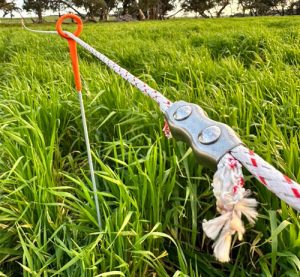Electric fencing technology has advanced in leaps and bounds and is now the smart way to do fencing because it trains animals about boundaries without the damage that arises from barbed wire.
Why is electric fencing something to ponder on small acreage farms?
Firstly, the systems for electric fencing now are a lot smaller and they’re more cost effective. You can also start with a base unit and then add on to that as you need to. Plus you can also add a solar component to it to reduce set up and power costs.
Secondly, systems are now available at many different price points. Whereas once upon a time you would get your fencing contractor to put an electric fence on at the time of putting your fence up, now you can retrofit them to existing fences and, with the right amount of knowledge, you can even install them yourself.
We’d like to see more people move away from using barbed wire because if you use plain wire instead of barbed wire and add an electric fence, you get a better, safer system for your animals.

Electric fencing is a smart tool for smart animals
You might say electric fencing is a training tool not a punishment tool because both sheep and cattle are incredibly smart.
They touch their nose on it once, and they don’t like it.
And there are also visual signals we use thanks to some step-ins we use around the fence line. There are some that come in white but we prefer the orange ones.
So when Harriot the Heifer comes and touches her nose on the electric fence, and goes oh, I don’t like that and look, it’s orange. When she comes along to the next one she says, orange, I don’t like that.

Electric fencing and strip grazing
Another great use of electric fencing is for strip grazing.
Strip grazing has been around forever, but it is starting to be used more frequently as our clients try to more efficiently use the pastures they have available.
For example, here in Currency Creek, we grow barley, which we use as a cleanup crop because we’ve got a lot of cooch grass in there. It’s a two to three year program to clear up some cooch grass in that paddock. This year, with barley in it, we are going to segment off using electric fencing.
We pen the animals in one part so they can graze intensively, and then we move the fence. Dairy farmers do this all the time. They often have a single electric fence and the dairy cattle have leared to comply, knowing they’re in this section today and will be in another section tomorrow.
If you have cattle just grazing, they’re lazy. They’ll devour the good tasting sweet stuff first and then just trample the rest. But you are responsible for managing the land so you’ve got to make everything work as efficiently as possible.
And this actually lends itself to sustainability too, because you can make sure that you are hitting where there’s the good stuff and letting the other parts of the property recover.

First step in planning an electric fence
Traditionally when farmers use an electric fence for strip grazing, they start at one end where you put your electric unit in, and then they take it all the way up to the other end where they want to stop it.
This means you have to get that electricity all the way from your base station up the other end of your property.
Instead, what we recommend these days is planning the best place for your base station first.
Typically, this means putting that base station in the middle of your paddock; otherwise, the further away you get from your base station, the less electricity you’re going to have.
So by putting your base station in the middle, you are going to get a better, more efficient outcome.
And the other thing that’s important to address first is earthing because people who’ve had bad experiences with electric fencing almost always do so because of poor earthing.
So before you throw the baby out with the dishwater, we can come in and help you diagnose what’s wrong.
If you want to explore this, you can make contact and we’ll have a chat to see if it is a good solution for you.
